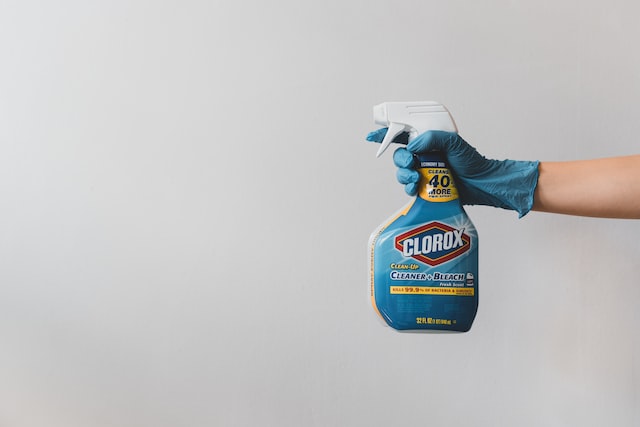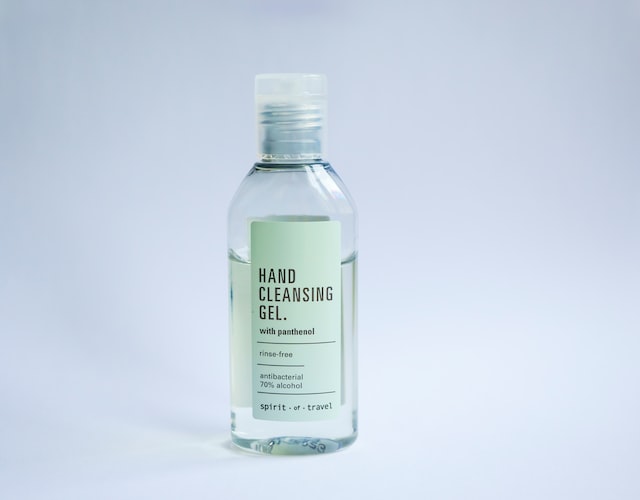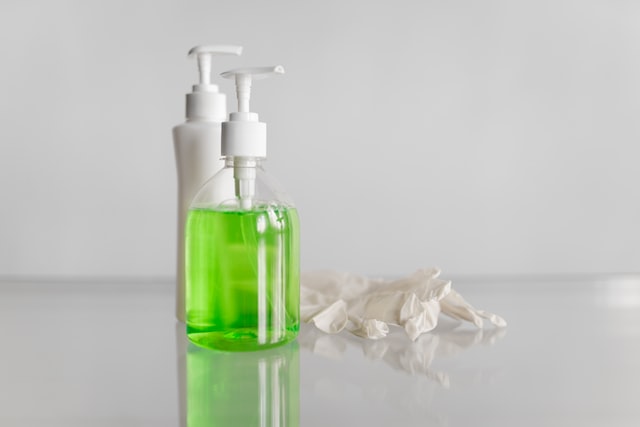Disinfectants are chemical agents that eliminate most or all pathogenic microorganisms on inanimate surfaces. Antibacterials are agents that kill or slow the growth of bacteria, but may not be effective against viruses or fungi.
What is a disinfectant?
(Photo by Clay Banks on Unsplash )

Disinfectants are agents that are applied to inanimate objects to destroy microorganisms. Unlike antibiotics, which are given to treat infections, disinfectants do not destroy or inhibit the growth of bacteria, viruses, and fungi. Instead, they work by physically removing the organisms from surfaces. Some common disinfectants include bleach, hydrogen peroxide, and alcohol.
While disinfectants are effective at killing many different types of germs, they are not typically used on humans because they can also be harmful. When used on skin or mucous membranes (such as the eyes or nose), disinfectants can cause irritation and even burns. For this reason, it is important to follow the instructions on the label carefully and only use disinfectants as directed.
What is an antibacterial?
(Photo by Neil Bates on Unsplash )

An antibacterial is an agent, such as a drug or chemical, that is designed to kill or inhibit the growth of bacteria. It can be used to treat bacterial infections or as a preventative measure to reduce the risk of infection.
The difference between disinfectant and antibacterial
Disinfectants and antibacterials are both agents used to kill or reduce the growth of microorganisms, but they differ in their specific actions and applications.
Disinfectants are chemicals or physical agents that are used to eliminate or reduce the number of pathogenic microorganisms on surfaces and objects. They work by disrupting the cell membrane, denaturing proteins, or interfering with metabolic processes of the microorganisms. Disinfectants are typically used on inanimate objects and surfaces, such as medical equipment, floors, and countertops, and are important in preventing the spread of infectious diseases. Examples of disinfectants include bleach, hydrogen peroxide, and alcohol.
Antibacterials, on the other hand, are agents that specifically target bacteria and are used to kill or inhibit their growth. They can be used to treat bacterial infections in humans and animals, such as pneumonia, skin infections, and urinary tract infections. Antibacterials can also be used prophylactically to prevent bacterial infections, such as in the case of surgical prophylaxis. Antibacterials work by targeting specific components of bacterial cells, such as their cell walls, protein synthesis machinery, or DNA replication machinery. Examples of antibacterials include penicillin, cephalosporins, and fluoroquinolones.
While both disinfectants and antibacterials have important roles in controlling the spread of infectious diseases, it is important to use them appropriately and follow instructions for use and safety precautions. Overuse or misuse of disinfectants and antibacterials can lead to the development of resistant microorganisms, making them less effective over time.
When to use disinfectant and antibacterial?
Disinfectants are typically used to kill or eliminate pathogenic microorganisms, such as bacteria, viruses, and fungi, on inanimate surfaces and objects. They are commonly used in healthcare settings, such as hospitals and clinics, to prevent the spread of infectious diseases. Disinfectants are also used in food processing facilities and in homes to sanitize surfaces and reduce the risk of contamination from harmful microorganisms.
Antibacterials, on the other hand, are agents that kill or inhibit the growth of bacteria. They can be used to treat bacterial infections in humans and animals, such as ear infections, urinary tract infections, and skin infections. Antibacterials can also be used as a preventative measure to reduce the risk of bacterial infections, such as in the case of prophylactic antibiotics given before surgery.
It is important to note that not all disinfectants are effective against all microorganisms, and not all antibacterials are effective against all types of bacteria. It is also important to follow instructions for use and safety precautions for both disinfectants and antibacterials, as improper use can result in adverse health effects.
Precautions to take when using disinfectant and antibacterial
When using disinfectants and antibacterials, it is important to take certain precautions to ensure safe and effective use.
- Follow instructions for use: It is important to read and follow the instructions on the label of the product, including the recommended dilution, contact time, and any safety precautions.
- Wear protective equipment: When using disinfectants and antibacterials, it is important to wear gloves, goggles, and other protective equipment as recommended on the label.
- Ventilate the area: Disinfectants and antibacterials can produce fumes that may be harmful if inhaled, so it is important to ventilate the area by opening windows or turning on fans.
- Do not mix products: Mixing disinfectants and antibacterials can produce harmful chemicals and reduce their effectiveness, so it is important to use them separately and as recommended on the label.
- Store safely: Disinfectants and antibacterials should be stored out of reach of children and pets, in a cool and dry place away from direct sunlight.
- Use appropriate disinfectants: Use the appropriate disinfectant or antibacterial for the specific application or situation. Not all disinfectants are effective against all microorganisms, and not all antibacterials are effective against all types of bacteria.
- Do not overuse: Overuse of disinfectants and antibacterials can lead to the development of resistant microorganisms, making them less effective over time. Use only as recommended on the label.
By following these precautions, the use of disinfectants and antibacterials can be effective in controlling the spread of infectious diseases and preventing bacterial infections.
What is the difference between disinfectant and antibiotic?
Disinfectants and antibiotics are both agents used to kill or reduce the growth of microorganisms, but they differ in their specific actions and applications.
Disinfectants are chemicals or physical agents that are used to eliminate or reduce the number of pathogenic microorganisms on surfaces and objects. They work by disrupting the cell membrane, denaturing proteins, or interfering with metabolic processes of the microorganisms. Disinfectants are typically used on inanimate objects and surfaces, such as medical equipment, floors, and countertops, and are important in preventing the spread of infectious diseases.
Antibiotics, on the other hand, are medications that are used to kill or inhibit the growth of bacteria in humans and animals. They work by targeting specific components of bacterial cells, such as their cell walls, protein synthesis machinery, or DNA replication machinery. Antibiotics are typically used to treat bacterial infections, such as pneumonia, skin infections, and urinary tract infections.
What is the difference between disinfectant and antiseptic?
Disinfectants and antiseptics are both agents used to kill or reduce the growth of microorganisms, but they differ in their specific actions and applications.
Disinfectants are chemicals or physical agents that are used to eliminate or reduce the number of pathogenic microorganisms on surfaces and objects. They work by disrupting the cell membrane, denaturing proteins, or interfering with metabolic processes of the microorganisms. Disinfectants are typically used on inanimate objects and surfaces, such as medical equipment, floors, and countertops, and are important in preventing the spread of infectious diseases.
Antiseptics, on the other hand, are agents that are used to kill or inhibit the growth of microorganisms on living tissues, such as skin or mucous membranes. They work by disrupting the cell membrane, denaturing proteins, or interfering with metabolic processes of the microorganisms. Antiseptics are typically used to prevent infections in wounds or during surgical procedures, and can also be used for personal hygiene purposes, such as hand sanitizers or mouthwash.
What are the types of disinfectants?
There are many types of disinfectants, each with its own advantages and disadvantages. Some of the most common types are bleach-based, alcohol-based, quaternary ammonium compound-based, and phenolic-based.
Bleach-based disinfectants are some of the most effective at killing a wide range of microorganisms, including bacteria, viruses, and fungi. However, they can also be corrosive to surfaces and irritating to skin and eyes. Alcohol-based disinfectants are less effective against certain types of bacteria and viruses, but are less corrosive and easier to handle than bleach-based products. Quaternary ammonium compound-based disinfectants are effective against a wide range of microorganisms, but can be toxic if ingested or inhaled. Phenolic-based disinfectants are effective against bacteria and fungi, but can be irritating to skin and eyes.
What are the types of antibacterial?
There are two main types of antibacterial: Bactericidal and Bacteriostatic.
Bactericidal antibiotics kill bacteria, while bacteriostatic antibiotics prevent bacteria from growing. Some antibiotics, such as penicillin, are effective against a wide range of bacteria. Others, such as erythromycin, are effective against only a few types of bacteria.
The health benefits of using disinfectant and antibacterial
There are many benefits to using disinfectant and antibacterial products around the home. They can help to prevent the spread of harmful bacteria and viruses, and can also help to keep surfaces clean and free from harmful contaminants.
Disinfectants are typically used on hard surfaces, such as countertops, floors, and doorknobs. They work by killing or inactivating bacteria and viruses on these surfaces. This can help to reduce the risk of spreading infection.
Antibacterial products are usually used on softer surfaces, such as fabrics and upholstery. They work by Killing or inhibiting the growth of bacteria on these surfaces. This can help to prevent the buildup of harmful bacteria that can cause illness or infection.
Featured Image By – Photo by Anastasia Nelen on Unsplash








